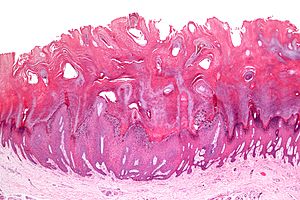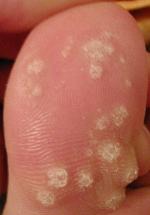Wart facts for kids

Warts are small, rough growths on your skin. They often look like solid blisters. Sometimes, pressing on a wart can cause pain. Warts are caused by tiny germs called viruses, specifically from the HPV family. Since there are many types of HPV viruses, there are also many different kinds of warts. Most warts are not dangerous, but they can sometimes be painful.
These viruses infect your skin cells. If these infected skin cells move to other parts of your body, new warts can start to grow there. Warts have tiny blood vessels inside that can bleed easily. If a wart bleeds, the virus can spread to other areas. Generally, touching infected skin or objects that have touched infected skin can spread the virus.
Your body has different ways to get rid of warts. Your immune system (your body's defense system) can fight the virus and make the wart disappear on its own. There are also special drugs, often containing acids, that can be put on the wart. These acids slowly kill the skin cells infected by the virus. Other medicines can help make your immune system stronger to fight the wart. Sometimes, doctors use methods like lasers, electricity, or special light to remove warts. These methods can sometimes leave scars.
Contents
What are the Different Types of Warts?
There are several types of warts, each caused by a different HPV virus:
- Common wart: This wart sticks out and has a rough surface. You usually find them on hands or knees.
- Flat wart: These are small, smooth, and flat. Many can appear at once, often on the face, neck, hands, wrists, and knees.
- Filiform or digitate wart: These warts look like tiny threads or fingers. They are most common on the face, especially near the eyelids and lips.
- Plantar wart: This is a hard, sometimes painful lump, often with tiny black dots in the middle. You usually find them on the soles of your feet or on your hands, especially where you put pressure.
- Mosaic wart: This is when many plantar warts grow very close together. They are usually found on the hands or the soles of the feet.
How Can You Get Rid of Warts?
There are several ways to treat and remove warts:
- Over-the-counter medicines: You can buy some medicines without a prescription. These often contain an acid like salicylic acid. To use them, you clean the area around the wart and apply the acid. This slowly kills the wart tissue. You can then gently remove the dead skin. This process usually takes several weeks. Stronger acids, like chloroacetic acid or silver nitrate, might be prescribed by a doctor. All these acids are caustic, meaning they can harm healthy skin. So, you need to protect the skin around the wart before applying the medicine.
- Freezing (Cryotherapy): A doctor, often a skin specialist, can freeze the wart using extreme cold, like liquid nitrogen. This method is called cryotherapy. Before freezing, a doctor might use a local anesthetic to numb the area and reduce pain. Freezing can sometimes cause scars.
- Special medicines (Cytostasis): Sometimes, a doctor might use a special type of chemotherapy called cytostatis. This medicine stops the wart cells from growing.
- Boosting your immune system: Some treatments focus on helping your immune system fight the wart virus better. This can help your body clear the wart on its own.
Images for kids
-
Despite their appearance, toads do not cause warts.
-
Liquid nitrogen spray tank used for freezing warts.
-
Two viral warts on a middle finger being treated with acid.
See also
 In Spanish: Verruga para niños
In Spanish: Verruga para niños






